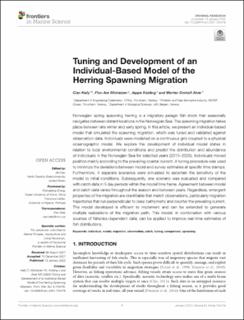| dc.contributor.author | Kelly, Cian | |
| dc.contributor.author | Michelsen, Finn Are | |
| dc.contributor.author | Kolding, Jeppe | |
| dc.contributor.author | Alver, Morten | |
| dc.date.accessioned | 2022-10-21T07:02:16Z | |
| dc.date.available | 2022-10-21T07:02:16Z | |
| dc.date.created | 2022-01-18T16:08:56Z | |
| dc.date.issued | 2022 | |
| dc.identifier.citation | Frontiers in Marine Science. 2022, 8 1-14. | en_US |
| dc.identifier.issn | 2296-7745 | |
| dc.identifier.uri | https://hdl.handle.net/11250/3027452 | |
| dc.description.abstract | Norwegian spring spawning herring is a migratory pelagic fish stock that seasonally navigates between distant locations in the Norwegian Sea. The spawning migration takes place between late winter and early spring. In this article, we present an individual-based model that simulated the spawning migration, which was tuned and validated against observation data. Individuals were modelled on a continuous grid coupled to a physical oceanographic model. We explore the development of individual model states in relation to local environmental conditions and predict the distribution and abundance of individuals in the Norwegian Sea for selected years (2015–2020). Individuals moved position mainly according to the prevailing coastal current. A tuning procedure was used to minimize the deviations between model and survey estimates at specific time stamps. Furthermore, 4 separate scenarios were simulated to ascertain the sensitivity of the model to initial conditions. Subsequently, one scenario was evaluated and compared with catch data in 5 day periods within the model time frame. Agreement between model and catch data varies throughout the season and between years. Regardless, emergent properties of the migration are identifiable that match observations, particularly migration trajectories that run perpendicular to deep bathymetry and counter the prevailing current. The model developed is efficient to implement and can be extended to generate multiple realizations of the migration path. This model, in combination with various sources of fisheries-dependent data, can be applied to improve real-time estimates of fish distributions. | en_US |
| dc.language.iso | eng | en_US |
| dc.publisher | Frontiers | en_US |
| dc.rights | Navngivelse 4.0 Internasjonal | * |
| dc.rights.uri | http://creativecommons.org/licenses/by/4.0/deed.no | * |
| dc.title | Tuning and Development of an Individual-Based Model of the Herring Spawning Migration | en_US |
| dc.title.alternative | Tuning and Development of an Individual-Based Model of the Herring Spawning Migration | en_US |
| dc.type | Peer reviewed | en_US |
| dc.type | Journal article | en_US |
| dc.description.version | publishedVersion | en_US |
| dc.rights.holder | Copyright © 2022 Kelly, Michelsen, Kolding and Alver. This is an open-access article distributed under the terms of the Creative Commons Attribution License (CC BY). The use, distribution or reproduction in other forums is permitted, provided the original author(s) and the copyright owner(s) are credited and that the original publication in this journal is cited, in accordance with accepted academic practice. No use, distribution or reproduction is permitted which does not comply with these terms. | en_US |
| dc.source.pagenumber | 1-14 | en_US |
| dc.source.volume | 8 | en_US |
| dc.source.journal | Frontiers in Marine Science | en_US |
| dc.identifier.doi | 10.3389/fmars.2021.754476 | |
| dc.identifier.cristin | 1983919 | |
| dc.relation.project | Sigma2: ns9828k | en_US |
| dc.relation.project | Sigma2: nn9828k | en_US |
| dc.source.articlenumber | 754476 | en_US |
| cristin.ispublished | true | |
| cristin.fulltext | original | |
| cristin.qualitycode | 1 | |

